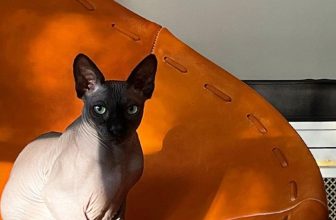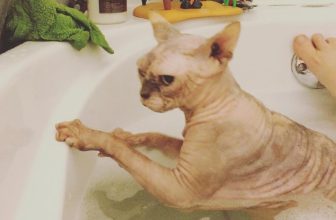Sphynx cats have a soft, energetic temperament and an unusual appearance that many animal lovers like so much. However, these hairless pets can have some health problems because they don’t have fur. Body hair acts as a protective barrier for fluffy cats. Ear hair also collects dirt and wax. On the contrary, their absence or minimal amount increases the risk of ear infections. Treatment involves oral antibiotics and the application of special ointments. It’s unlikely that your pet will like it.
Therefore, you need to know how to clean sphynx ears. Regular grooming will help keep your hairless cat healthy. It is better to prevent a serious problem from occurring than to solve it. After all, what could be better than seeing your cat carefree and energetic?
How to Clean Hairless Cat’s Ears
- Use products recommended by your veterinarian for cleaning.
- Clean your pet’s ears 1-2 times a week.
- Do it before or after bathing.
- Place swabs moistened with a cleaner in the ears for a couple of minutes.
- Carefully collect the residual wax with wet wipes or pads.
- Pay attention to the color and smell. Unusual discharge or odor means there is an infection.
Sphynx Ear Wax Removal Guide
The main factors in keeping your cat’s ears healthy are choosing the right cleaning products, regularity, and accuracy.
Why are sphynx cats prone to dirty ears?
Sphynx cat’s ears are beautiful and huge. This is one of the distinguishing characteristics of this breed. Many owners wonder: Why are my cat’s ears always dirty?
- One of the reasons is the large size of the ears. Dust and dirt collect faster because of this factor.
- The second reason is the absence of hairs that would collect sulfur and dust particles.
- Hairless cats also have oily skin.
All these factors lead to quick scurf accumulation in the ear and its hardening without proper, regular care. Sphynx cat’s ear wax typically has a brown, dark brown, or even black color.
How to clean sphynx cat’s ears step-by-step
- Before purchasing special ear drops and wet wipes, ask your veterinarian which options are safe for your pet. Do not use products intended for human hygiene.
- Before cleaning the cat’s dirty ears, prepare all the necessary supplies. You will need drops, cotton pads, pet wet wipes, and cotton buds. It is necessary to quickly carry out the procedure so that the animal does not start to get nervous.
- You can put tampons soaked in ear cleaner before bathing so that it has time to soften the wax. It is also acceptable to start cleaning after taking a bath.
- Do not pour the cleaner into the ear as this will cause discomfort to the pet.
- Take a clean disc and soak it with the product. Gently place the tampons into your pet’s ears. Leave them for a while according to the product’s instructions. The ear cleaner will soften the dirt and wax. It also has an antimicrobial effect.
- When the time is up, carefully remove the swabs from the ears.
- Take a damp wipe or a clean disc. Clean up softened residues.
- Using a cotton q-tip, collect the remaining dirt from the ear outward. Do not stick the wand too deep to avoid injury to the ear canal. Change cleaning tools until they are clean after wiping.
- Never pour water into a pet’s ear. This can lead to inflammation and bacterial infection.
- When cleaning, pay attention to the smell and color of wax. An uncharacteristic color, ear discharge, and an unpleasant smell might indicate that the animal has a yeast infection or other disease. In this case, mere cleansing will not be enough. You will need to visit a veterinary clinic.
- Head shaking, constant crying, and itching can also be symptoms of an ear infection in your sphynx.
- Remove the dirt not only from inside the ear canal but also from the outer part of it as dust and oil accumulate there. It is best to use wet wipes for animals to do this.
- Do not forget about psychological comfort. During the manipulation of the ears, talk to your pet and hold it carefully. You can give a favorite treat to your hairless cat before or after cleaning.
How often to clean sphynx ears
Kitten ears dirty residues appear very quickly. Accumulations of sulfur with dust and dirt harden. If you do not regularly clean the ears, the wax will be difficult to remove. Also, a large amount of dirt provokes the growth of bacteria that lead to the development of ear infections. Therefore, it is essential to carefully maintain your pet and wipe its big ears at least once a week. Veterinarians recommend removing sulfur deposits twice a week. Daily cleaning is also harmful. This can cause severe skin irritation.
Keep the Cute Sphynx Ears Healthy
At first glance, it might seem that sphinxes are too demanding to care for. In fact, it is important to clean their ears regularly and correctly, and you will soon get used to it. Careful actions and gentle handling of the pet will also make the cat feel comfortable. A caring owner wants their pet to be healthy and cheerful. Breed characteristics can lead to various problems. If you follow these instructions, you will minimize the risk of different infections.
Read also about sphynx cats
- How to Breed Sphynx Cats
- How to Get a Sphynx Cat
- How to Bathe a Sphynx Cat
- How to Care for Sphynx Cats
- Best Dry Food for Sphynx Cats
- Best Cat Food for Sphynx
- Best Shampoo for Sphynx Cats
- Best Litter for Sphynx Cats
- What Color Are Sphynx Cats
How do you calm your sphynx cat while cleaning the ears? Share your experience in the comments.







